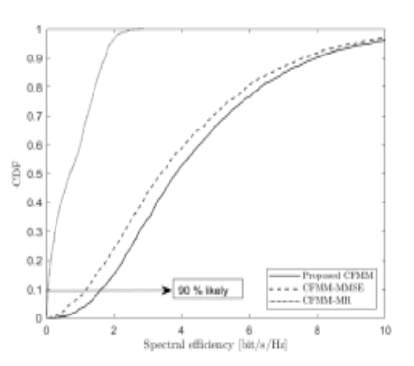


Indian Journal of Science and Technology
Year: 2024, Volume: 17, Issue: 5, Pages: 465-477
Original Article
Swapnaja Deshpande1, Mona Aggarwal1*, Pooja Sabherwal1, Swaran Ahuja1
1MDE Department, The NorthCap University, Gurgaon, Haryana, India
*Corresponding Author
Email: [email protected]
Received Date:21 November 2023, Accepted Date:28 December 2023, Published Date:31 January 2024
Objectives: The performance of Cell-Free Massive Multiple Input Multiple Output (CFMM) is analyzed in this paper for its two bottlenecks i.e., Pilot Contamination (PC) and Channel Estimation Error (CEE). Methods: The CFMM network is strongly affected by PC which is one of the bottlenecks due to which quality of service and accuracy of channel estimation gets impacted. Therefore, we address this problem by presenting advanced pilot assignment algorithm to mitigate PC and deep learning aided channel estimation for reducing CEE for the CFMM systems to maximize spectral efficiency (SE). We derive achievable uplink and downlink SE expressions for the proposed system, and compare with Minimum Mean Square Error and Maximum Ratio combining techniques. As well, the performance is evaluated for different antenna configurations. The advanced pilot assignment algorithm is compared with greedy pilot assignment and random pilot assignment methods. The performance of cellular massive multiple input multiple output (MIMO) is derived for comparison. The performance of CFMM system is evaluated using MATLAB software. Findings: The UL and DL performance of the proposed system in terms of SE is 3.2 times higher than the conventional CFMM with MMSE and MR combining techniques. Average sum spectral efficiency of the proposed system increases with increase in number of access points (APs). Comparison with different antenna configurations reveals that, with 400 APs equipped with single antenna, only UE with good channel condition shows performance enhancement, but when each AP is equipped with 4 antennas, the UE with unfavourable channel condition also give better performance. Advanced pilot assignment scheme proves to be better than greedy and random pilot assignment techniques. For the same cellular set up, the proposed CFMM system achieves higher SE than the cellular massive MIMO. Novelty: Due to the advanced pilot assignment algorithm used in the proposed CFMM system, at a time, only one AP is selected and the selected AP with its full received power serves the desired UE, which suppresses interference resulting in improved SE performance. The serving AP is selected considering the distance between UE and AP, rather than using large scale fading coefficient which is the unique feature of pilot assignment algorithm. The proposed deep learning-aided channel estimation method, minimizes the mean square error (MSE) between the actual channel and the channel estimates obtained from the MMSE estimation resulting in reduction in channel estimation error. Thus, the use of the proposed advanced pilot assignment algorithm and deep learning-aided channel estimation method increase the SE performance of the CFMM system.
Keywords: CellFree Massive Multiple Input Multiple Output, Pilot Contamination, Channel Estimation Error, Minimum Mean Square Error, Maximum Ratio
© 2024 Deshpande et al. This is an open-access article distributed under the terms of the Creative Commons Attribution License, which permits unrestricted use, distribution, and reproduction in any medium, provided the original author and source are credited. Published By Indian Society for Education and Environment (iSee)
Subscribe now for latest articles and news.